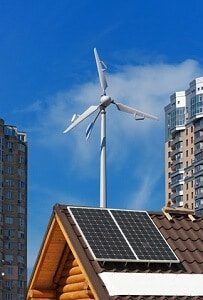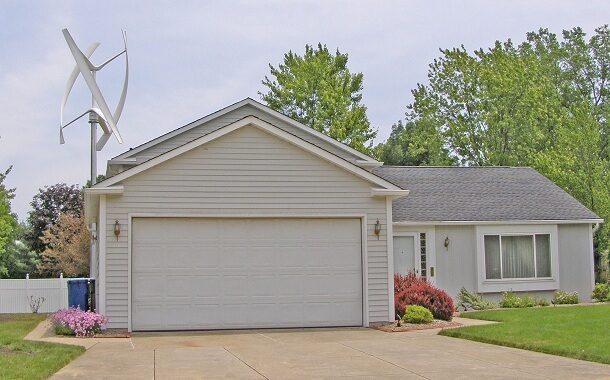How Much Does a Home Windmill Cost?
Last Updated on February 16, 2024
Written by CPA Alec Pow | Content Reviewed by ![]() CFA Alexander Popinker
CFA Alexander Popinker
Installing a wind turbine at your home can provide clean, renewable energy and reduce your electricity bills. But how much does a residential windmill cost?
In this article, we’ll look at windmill prices, additional costs, financial incentives, and factors to consider when deciding if wind power is right for your home.
Investing in a home wind turbine is a major decision. While windmills require an upfront investment, they can provide energy independence and long-term savings on electricity.
Prices for complete installed systems typically range from $15,000 to $50,000 depending on the size, location, difficulty of installation, and other factors.
How Much Does a Home Windmill Cost?
For a small residential wind turbine producing 5 to 15 kilowatts, expect to pay $3,000 to $8,000 for the turbine itself. Larger systems in the 10 to 100-kilowatt range generally cost $15,000 to $50,000 installed.
Installation fees account for about 25% of the total cost. These include the tower, foundation, wiring, permits, and labor for installation. Expect to pay at least $5,000 to $10,000 for installation alone.
The total installed cost for a home windmill can vary dramatically based on:
- Turbine size – More capacity means higher power generation potential. But larger turbines are more expensive.
- Location – Zoning laws, permitting requirements, and wind speeds impact cost.
- Grid connection – Connecting to the utility grid requires an interconnection study.
- Installation complexity – Difficult sites, taller towers, and custom foundations add expense.
- DIY vs professional – Self-installing a windmill kit costs less but requires expertise.
Despite the high upfront cost, home wind turbines can provide free electricity once paid off. And state/federal tax credits and incentives are available to offset the initial investment.
According to Windustry.org, wind turbines under 100 kilowatts cost roughly $3,000 to $8,000 per kilowatt of capacity. A 10-kilowatt machine (the size needed to power a large home) might have an installed cost of $50,000-$80,000 (or more).
Smaller farm or residential scale turbines cost less overall but are more expensive per kilowatt of energy-producing capacity. The site also provides cost comparisons with other top competitors.
TheRoundup.org writes that the American Wind Energy Association (AWEA) estimates the upfront cost of a wind turbine to range between $2,000 and $5,000.
Assuming that you want the turbine to supply 100% of your electricity, you might need a 15 kW turbine (depending on your house size and energy consumption), which would cost approximately between $30,000 and $75,000.
The ongoing cost of maintenance is relatively low, averaging around $200-$300 per year. Wind turbines typically take between five and 15 years to pay for themselves.
GoAnanta.com notes that small wind turbines can cost between $3,000 and $5,000 per kilowatt of energy capacity, which comes to around $15,000 and $75,000 for expected installation project costs.
The site also discusses factors that impact the cost of home wind turbine installation, such as the quality of the turbine, the average wind speed in the area, and building codes and regulations.
Types of Home Windmills
There are two main configurations for small wind turbines:
Horizontal axis – The classic propeller-style turbine with blades rotating on a horizontal shaft. Most productive in open areas.
Vertical axis – Blades revolve around a vertical shaft. Benefits include omnidirectional operation.
Popular brands like Bergey, Skystream, and Quiet Revolution offer sizes from 1 to 100 kW. Compare models to find the best fit for your site’s wind resource, energy needs, zoning laws, and budget.
Larger turbines generally cost more but have higher energy production potential. Consider starting small to gain experience with wind power before expanding your system.
Factors Influencing Windmill Costs
The main factors that determine home windmill costs include:
Initial Purchase Price
The turbine itself accounts for around 75% of the total installed cost on average. More capacity means higher power output potential but also a higher purchase price.
Installation Expenses
Installing a wind turbine involves foundation construction, electrical work, grid connection, permitting fees, and more. Expect installation to add 25-30% to the system cost.
Operation and Maintenance
Regular maintenance is crucial to maximize energy production and turbine lifespan. Budget around $100-$500 annually for maintenance costs.
Power Output
The size of the turbine (in kW) influences how much electricity it can generate. Prioritize sufficient capacity for your location rather than just the lowest cost.
You might also like our articles on the cost of transferring utilities, getting utilities on your land, or moving a gas meter.
Site Conditions
Factors like zoning rules, wind speeds, and construction challenges impact permit fees, foundation expenses, tower height, and other costs.
Take the time to understand all the costs before making an investment in a residential wind turbine. Get multiple quotes and ask lots of questions to ensure the system is properly sized for your needs and budget.
Financial Incentives and Savings
While windmills involve a significant upfront cost, there are financial incentives available to help offset the investment in a renewable energy system:
- Federal tax credit – Get 26% of the total system cost back as a tax credit.
- State/local rebates – Some states offer rebates of $1,000 or more per turbine.
- Net metering – Many utilities pay retail rates for excess power sent back to the grid.
- Lower energy bills – Electricity produced offsets power purchased from your utility.
- Accelerated depreciation – Recover capital costs faster as a business expense.
- Renewable energy credits – Can be sold in some markets for additional revenue.
- Feed-in tariffs – Utilities pay set rates for your generated renewable power.
Crunching the numbers on incentives and energy cost savings can determine your return on investment timeline, often 5-10 years for a wind turbine. Contact your utility and state energy office to find available incentives.
The Environmental Protection Agency estimates home wind systems can reduce electricity bills by 50-90% when properly sited. While windmills require an upfront investment, the long-term savings make it a cost-effective energy solution.
Choosing the Right Windmill
Selecting the optimal windmill involves assessing your wind resource, energy needs, zoning and permit requirements, installation options, and turbine models. Key steps include:
Assessing Your Wind Resource
Use the Department of Energy’s WindExchange tool to estimate your annual wind speeds. Turbines require average yearly wind speeds of at least 10 mph to operate effectively. Installing a measurement system for 12+ months provides the most accurate on-site data.
Zoning and Permit Requirements
 Local zoning laws and permitting regulations impact what type/size turbines are allowed and their placement on your property. Getting zoning approval and securing permits takes time, so start the application process early.
Local zoning laws and permitting regulations impact what type/size turbines are allowed and their placement on your property. Getting zoning approval and securing permits takes time, so start the application process early.
Determining the Appropriate Size
Choose a turbine rated for higher power output than your location’s wind resource can support. Consider starting small and then potentially expanding once you gain experience with wind energy.
Researching Manufacturers
Compare specifications, prices, warranties, and reviews for brands like Bergey, Skystream, Quiet Revolution, and others to select the right model for your needs.
Deciding on DIY vs Professional Installation
Consider a DIY turbine kit to save on labor costs if you have construction experience. Or hire a certified wind professional for proper siting and safe, reliable installation.
Take the time upfront to carefully evaluate your options – the right turbine choice and setup is key to maximizing energy production and return on investment.
Installation Process and Providers
Once you’ve selected the perfect wind turbine model for your location, the next step is installation. Key considerations include:
Hiring Certified Installers
Choose installers accredited by the Small Wind Certification Council for safe, reliable wind turbine and electrical setup.
Obtaining Necessary Permits
Your installers will handle technical zoning and permit applications. Be prepared for a potentially lengthy approval process.
Installing the Foundation and Tower
The foundation keeps the windmill stable under all conditions and may require excavation and concrete work. Typical tower heights are 50-140 feet.
Assembling the Turbine
Your installation team will fully assemble and test the turbine according to the manufacturer’s specifications.
Connecting to the Electrical Grid
Electrical work is required to safely tie your wind turbine into your home’s electrical system and the utility grid.
While hiring an experienced installation company is recommended for most homeowners, DIY turbine kits are an option if you have the skills, time, and determination to take on the project yourself.
Final Words
Investing in a wind turbine is a major decision that requires careful planning but can provide clean, renewable power. While windmills involve a significant upfront cost, incentives are available to reduce the initial investment.
Most importantly, wind energy can reduce electricity bills by up to 90% and provide energy independence. Assess your options to determine if wind power is right for your home.
Frequently Asked Questions
Are home wind turbines worth it?
Yes, home wind turbines can be a worthwhile investment for many homeowners due to the long-term energy bill savings, energy independence, and environmental benefits.
The factors in determining if a residential wind turbine will be cost-effective are the available wind resources, electricity costs in your area, incentives and rebates, turbine size, and how long you plan to remain in the home.
Get multiple quotes and run the numbers, but generally, a wind turbine can pay for itself in 5-10 years and then provide 20+ years of nearly free electricity.
Site assessment is critical – your location needs average annual wind speeds of at least 10 mph for a turbine to make financial sense. Work with reputable installers and follow zoning regulations to ensure your system operates optimally.
Weigh the costs and benefits carefully, but for homeowners with sufficient wind, installing a residential wind turbine is an investment that pays off over the system’s lifetime.
Is a windmill enough to power a house?
A single small wind turbine is generally not enough to fully power an entire house, but a home windmill can offset a sizable portion of a household’s electricity consumption.


Leave a Reply
Want to join the discussion?Feel free to contribute!